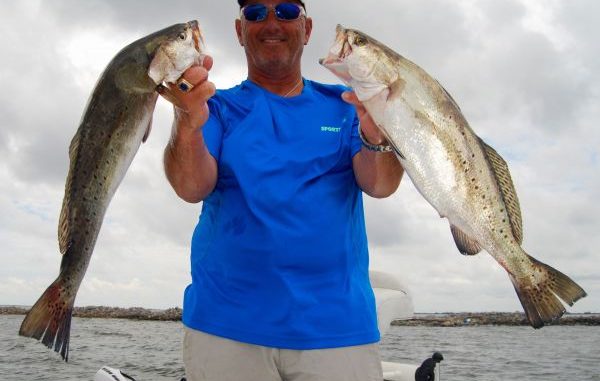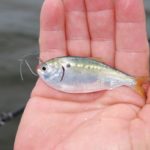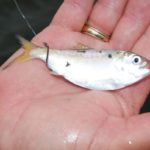
Vidrine cast nets for live bait to catch monster specks at Caminada Pass jetties
Carl ‘Tommy’ Vidrine was in full-on beast mode Monday morning — not intent with just catching specks, but focused instead on hauling in some real hammer trout on Grand Isle.
“I change modes about this time of year,” he said. “Anything close to having to measure, I just throw it back. I’m going mostly with live-bait only on just about every trip — we’re going after 3-, 4- and 5-pound fish.”
With last week’s full moon, Vidrine — an independent contractor for Aflac who lives in Baton Rouge — had been on an amazing run, steadily reeling in 20-, 22- and 24-inch fish all weekend long from his favorite spot on the southern tip of the Caminada Pass jetties across from Elmer’s Island.
Free-lined live shrimp and pogies are currently proving just too much for the big trout to pass up.
“It’s pretty much every cast, or every other cast,” he said. “When that green water is coming through there and the conditions are right, there’s no excuse not to catch them.”
It’s hard for some to believe that such giant specks are located only a five-minute boat ride from Bridge Side Marina, and while Vidrine made positioning his 24-foot Nautic Star look easy late Monday morning despite the ripping incoming tide, south wind and steady chop — it’s not necessarily simple to do.
Don’t be deceived — submerged boulders can make the spot hazardous, and Vidrine knows exactly where to cast so his free-lined live bait rides the current and winds up in full view of the hefty specks taking refuge down in the rocks below.
If the current is strong like on Monday, he’ll grudgingly add a single split-shot so the shrimp or pogie can get just a little deeper as it moves through the strike zone. So while his honey hole is close, it’s not necessarily an easy place to catch fish.
“When the tide is ripping, you can’t get the bait down, and fishing under a popping cork there won’t work in that current because the trout are down deep hiding behind those rocks,” Vidrine said. “So most people can’t do it because the current is blowing the bait back to them, and they get aggravated after a couple of casts. They want to move to another spot that’s more convenient and more comfortable, so they go to the bay on a reef and settle for the small fish there.
“They’re just not comfortable throwing that bait without enough weight on it. It’s not easy to do, but it’s productive if you learn how to do it and become skilled enough to throw it without backlashing. It’s also hard because you get hung up in the rocks a lot. A lot of fishermen won’t tolerate getting stuck and losing expensive tackle, so they just move. But if you want to catch big fish, you’ve got to lose a lot of hooks.”
Big fish are what he’s after, so for the next several months, live pogies, shrimp and croakers will be Vidrine’s go-to baits for speckled trout on Grand Isle — from the jetties to the beach to the Fourchon rocks.
You can buy shrimp and croakers at just about any marina, but the only way to get pogies in your livewell — and maybe catch a big speck with the shiny, live bait — is to catch them yourself.
Here are Vidrine’s Top 5 tips to catch big Grand Isle trout with live pogies:
1. Learn how to throw a cast net.
There’s no other way to get around this one. But take heart: Vidrine wasn’t always as proficient as he is now with a cast net, so he took the time to learn from an online tutorial. You can do the same thing.
“I Googled the best way to throw a cast net,” he said with a chuckle. “I tried three different ways, and the last one was pretty simple. Anybody can do it, if you practice.”
His best piece of advice: practice on land before you move to your boat, and get a feel for how often you’re able to get the net to spread open to its full diameter.
“I learned in my driveway, on solid ground,” he said. “When you want to learn, do it comfortably — not in a boat with the wind blowing while you rock around. Do it in an easy spot.”
And don’t buy a blue cast net — Vidrine said pogies can see it coming, so he suggested either a clear or white net to maximize your catch.
“They’ll see it in deeper water,” he said. “In shallow water, they don’t have a place to run, but in deeper water they see that blue coming down and scatter. In deep water, they’re way too fast and way too smart.”
2. Learn how to locate pogies on the water.
Once you’ve mastered the art of throwing a cast net and getting it to consistently spread open, the next step is to locate schools of pogies on the water. Vidrine said 4-inch pogies are ideal for big trout, but smaller ones can be used under a popping cork to catch smaller specks or redfish.
Sometimes he finds pogies on the beach, other times behind the island. But he always relies on Louisiana’s state bird to point him in the right direction.
“Look for pelicans first. If they’re diving, that gives me a general area,” he said. “I fill up the livewell so when I catch them, I can put them in. Then I cut off all the livewells.”
A stealthy approach is key so the fish don’t scatter, he said.
“You want to be as quiet as possible. No radio, and only one or no pumps on. And the trolling motor messes them up,” he said. “I’ll try to coast into them. I’ll have somebody driving the boat, and I’ll say, ‘Shut it off,’ and I’ll see where they’re flipping. If they don’t have time to see me or run away, boom — I’ll catch 50 in one cast.”
Once his livewell is full, Vidrine keeps it set to ‘fill’ instead of putting his aerator on.
“With the aerator on, I find they spit up and all this black stuff gets all over your well. I’ve never had them die like that, so I quit putting the aerator on.”
Speaking of livewells, Vidrine said it’s vital that it’s either completely round, or at least has rounded corners.
“It can’t be square,” he said. “They swim in circles, and after an hour or two, they’ll bump themselves and get red in the nose and weak if you have corners.”
Once you’ve spotted pelicans diving, the best indication of the presence of pogies is a ‘flip’ on the water’s surface, Vidrine said.
“When you see that flip — like when a bream hits the top of the water and makes a little splash — that’s key. So the pelicans get you to the location where they’re diving, then you shut everything down and let the wind carry you into where the pelicans are,” he said. “When the flip happens, I throw as close as I can — as fast as I can — to that flip. Sometimes I’ll get 50 in one cast. You do that two or three times, and you’re done. But sometimes it takes work.”
3. Use the right hook.
Vidrine uses a 2- or 3-aught kahle hook when he free-lines pogies — or croakers, for that matter.
“You need that bigger hook because there’s so much meat,” he said. “You need to set the hook and get that kahle hook into the deeper part of the trout’s jaw, and he’s not coming off.”
Typically, he hooks the pogies either through the lips, or near their butt.
“If you hook them through the lips, they’ll swim deeper,” Vidrine said. “That’s good, especially if the birds are chasing you, because they’ll see them on top of the water and try to come and eat them.
“If you’re in still water with no current, go through the back or by the butt.”
4. Be patient with the hookset.
This can be tough to master, especially if you’re used to fishing with a popping cork and giving the line an immediate jerk when your cork vanishes.
If you have enough bait on board, get rid of a pogie that’s lazy and doesn’t appear to be in much distress. A good strong pogie will usually give you a good indication of a pending strike, he said.
“When that pogie sees the trout, he’s going to start shaking real bad. When you can feel the tip of your rod shaking, that’s when you know you’ve got a good one,” Vidrine said. “When you feel that thump from the trout’s strike, if your rod tip is up, you need to give him at least 4 feet (of line) because it’s a big piece of meat. Then set the hook — hard. A lot of people get excited and don’t ever set the hook. If you don’t, it’s going to come right out, and your pogie is going to be dead.”
5. If you can’t catch pogies, buy live shrimp or croakers to free-line for big trout.
If the cast net just isn’t for you — or if you want to focus on spending all your time fishing — buy live shrimp or croakers if you want to free-line bait for a shot at bigger Grand Isle trout.
“Shrimp are probably the easiest live bait because you can buy them almost all year long,” Vidrine said. “I like to have a little of each in both livewells — a swimming shrimp in one and fish in the other, either a pogie or a croaker. You just can’t go wrong that way.”
If he’s fishing with live shrimp, Vidrine has been using an Owner 1/0 all purpose bait hook (Model No. 5311-111).
“The negative about fishing with shrimp is the other fish want it, too. If you get a bite with a croaker, it’s almost always either a redfish or a trout — guaranteed,” he said. “And if you’ve got a bigger pogie, it’s either going to be a redfish or a trout — or maybe you’ll get a jack crevalle or something crazy like that.”
Using pogies is fun for him because lots of times he can see the swirl of the strike, depending on how deep the pogie swam down. And the results are typically just what Vidrine’s looking for when he’s in ‘beast mode.’
“It’s like a topwater fishing trip with live bait — with big fish only,” he said. “You’re not going to catch a 12- or 13- or 14-inch trout.
“They’re all going to be 18, 19, 20 or 25 inches.”






